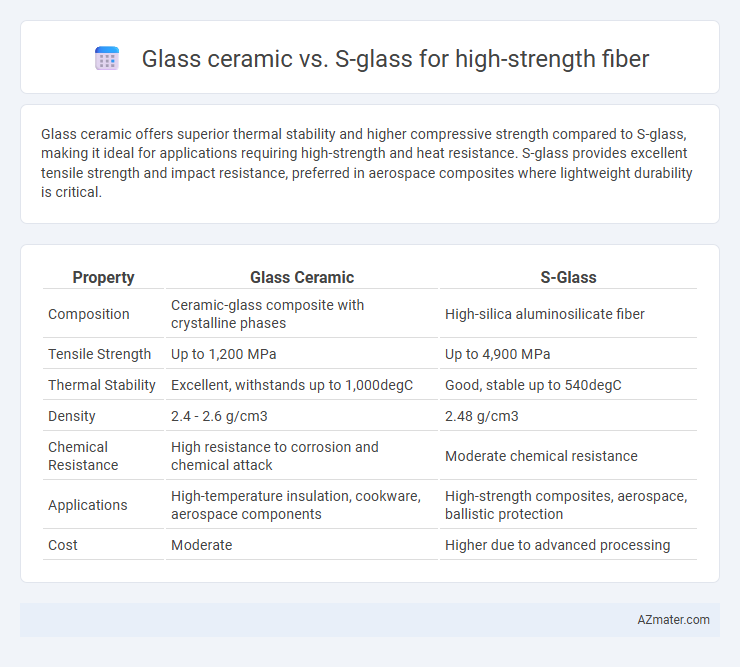Glass ceramic offers superior thermal stability and higher compressive strength compared to S-glass, making it ideal for applications requiring high-strength and heat resistance. S-glass provides excellent tensile strength and impact resistance, preferred in aerospace composites where lightweight durability is critical.
Table of Comparison
| Property | Glass Ceramic | S-Glass |
|---|---|---|
| Composition | Ceramic-glass composite with crystalline phases | High-silica aluminosilicate fiber |
| Tensile Strength | Up to 1,200 MPa | Up to 4,900 MPa |
| Thermal Stability | Excellent, withstands up to 1,000degC | Good, stable up to 540degC |
| Density | 2.4 - 2.6 g/cm3 | 2.48 g/cm3 |
| Chemical Resistance | High resistance to corrosion and chemical attack | Moderate chemical resistance |
| Applications | High-temperature insulation, cookware, aerospace components | High-strength composites, aerospace, ballistic protection |
| Cost | Moderate | Higher due to advanced processing |
Introduction to High-Strength Fibers
High-strength fibers such as glass ceramic and S-glass play crucial roles in advanced composite materials due to their superior mechanical properties and thermal stability. Glass ceramic fibers exhibit excellent resistance to high temperatures and chemical degradation, making them ideal for aerospace and industrial applications requiring prolonged durability. S-glass, known for its high tensile strength and impact resistance, provides outstanding performance in structural reinforcements where lightweight and strength are critical.
Defining Glass Ceramic and S-Glass
Glass ceramic is a composite material derived from controlled crystallization of certain glasses, offering enhanced mechanical strength, thermal stability, and resistance to thermal shock compared to conventional glass. S-glass, or high-strength aluminosilicate fiber, is designed specifically for superior tensile strength, high modulus, and durability in aerospace and industrial applications. Both materials serve high-strength fiber needs but differ fundamentally in composition and processing, with glass ceramic focusing on microstructural control and S-glass on fiber reinforcement properties.
Chemical Composition Differences
Glass ceramic fibers primarily contain silica (SiO2) combined with varying amounts of alumina (Al2O3), magnesium oxide (MgO), and other metal oxides, creating a crystalline structure that enhances thermal stability and mechanical strength. S-glass fibers consist mainly of silica (SiO2), alumina (Al2O3), and approximately 24% magnesia (MgO), designed to provide exceptional tensile strength and modulus compared to standard E-glass fibers. The key chemical composition difference lies in the higher magnesium oxide content and optimized ratio of alumina and silica in S-glass, which results in superior high-strength performance and improved resistance to chemical degradation.
Mechanical Properties Comparison
Glass ceramic fibers exhibit superior mechanical properties compared to S-glass fibers, particularly in tensile strength and modulus of elasticity, due to their crystalline structure that enhances stiffness and temperature resistance. S-glass fibers provide excellent strength-to-weight ratios with tensile strengths typically around 4.9 GPa and moduli near 85 GPa, while glass ceramic fibers often surpass these values, achieving tensile strengths upwards of 6 GPa and moduli exceeding 100 GPa. The enhanced mechanical performance of glass ceramic fibers makes them more suitable for high-temperature, high-stress applications requiring enhanced durability and dimensional stability.
Thermal Stability and Performance
Glass ceramic fibers exhibit superior thermal stability compared to S-glass fibers, maintaining their mechanical properties at temperatures exceeding 1000degC. S-glass fibers offer high tensile strength and excellent impact resistance but typically degrade above 600degC, limiting their use in extreme thermal environments. The enhanced performance of glass ceramic fibers under high heat conditions makes them ideal for aerospace and industrial applications requiring prolonged thermal exposure.
Strength-to-Weight Ratio Analysis
Glass ceramic fibers exhibit superior strength-to-weight ratios compared to S-glass fibers due to their enhanced mechanical properties and lower density. The crystalline microstructure of glass ceramics contributes to higher tensile strength and improved damage tolerance, resulting in more efficient load-bearing capacity per unit weight. S-glass fibers, while offering high tensile strength, have a slightly higher density which reduces their overall strength-to-weight efficiency in high-performance applications.
Durability and Environmental Resistance
Glass ceramic fibers exhibit superior durability and environmental resistance compared to S-glass fibers due to their enhanced thermal stability and chemical inertness. These fibers maintain structural integrity under high-temperature conditions and resist moisture, UV radiation, and chemical corrosion more effectively. S-glass fibers offer high tensile strength but are comparatively less resistant to environmental degradation, limiting their longevity in harsh applications.
Manufacturing Processes and Costs
Glass ceramics for high-strength fibers involve controlled crystallization processes that enhance mechanical properties but require precise thermal treatments, increasing manufacturing complexity and costs. S-glass fibers, produced through traditional melting and drawing techniques, offer high tensile strength with more streamlined manufacturing, leading to comparatively lower production expenses. The cost difference reflects the balance between the advanced crystallization control needed for glass ceramics and the well-established, scalable processes for S-glass fibers.
Applications in Industry and Technology
Glass ceramic fibers exhibit exceptional thermal stability and resistance to chemical corrosion, making them ideal for aerospace engine components and electronics insulation. S-glass fibers deliver superior tensile strength and impact resistance, widely utilized in aerospace structures, ballistic armor, and high-performance sporting equipment. Industrial applications prefer glass ceramic fibers for heat shielding and thermal barrier coatings, while S-glass dominates sectors demanding lightweight structural reinforcement and enhanced mechanical durability.
Selecting the Right Fiber for Your Needs
Glass ceramic fibers offer exceptional thermal stability and chemical resistance, making them ideal for applications requiring high-temperature durability. S-glass fibers provide superior tensile strength and impact resistance, suitable for structural reinforcement in aerospace and defense industries. Selecting the right fiber depends on specific performance requirements such as temperature tolerance, mechanical strength, and environmental exposure.

Infographic: Glass ceramic vs S-glass for High-strength fiber
 azmater.com
azmater.com